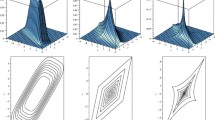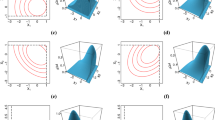Abstract
Stable distributions with elliptical contours are a class of distributions that are useful for modeling heavy tailed multivariate data. This paper describes the theory of such distributions, presents formulas for calculating their densities, and methods for fitting the data and assessing the fit. Efficient numerical routines are implemented and evaluated in simulations. Applications to data sets of a financial portfolio with 30 assets and to a bivariate radar clutter data set are presented.









Similar content being viewed by others
References
Abdul-Hamid H, Nolan JP (1998) Multivariate stable densities as functions of one dimensional projections. J Multivar Anal 67:80–89
Amengual D, Sentana E (2010) Inference in multivariate dynamic models with elliptical innovations. Available at https://www.researchgate.net/publication/228923497 (Preprint)
Boldyrev S, Gwinn C (2003) Scintillations and Lévy flights through the interstellar medium. Phys Rev Lett 91:131101
Bonato M (2011) Modeling fat tails in stock returns: a multivariate stable-GARCH approach. Comput Stat 27(3):499–521
Byczkowski T, Nolan JP, Rajput B (1993) Approximation of multidimensional stable densities. J Multivar Anal 46:13–31
Chambers J, Mallows C, Stuck B (1976) A method for simulating stable random variables. J Am Stat Assoc 71(354), 340–344 (Correction in JASA 82, 704 (1987))
Daul S, DeGiorgi E, Lindskog F, McNeil A (2003) The grouped t-copula with an application to credit risk. RISK 16(11):73–76
Dominicy Y, Ogata H, Veredas D (2010) Quantile-based inference for elliptical distributions. Available at http://ssrn.com/abstract=1006749
Higham NJ (2002) Computing the nearest correlation matrix—a problem from finance. IMA J Numer Anal 22:329–343
Kogon SM, Williams DB (1998) Characteristic function based estimation of stable parameters. In: Adler R, Feldman R, Taqqu M (eds) A practical guide to heavy tailed data. Birkhäuser, Boston, MA, pp 311–338
Kuruoglu E, Zerubia J (2004) Modeling SAR images with a generalization of the Rayleigh distribution. IEEE Trans Image Process 13(4):527–533
Lombardi MJ, Veredas D (2009) Indirect inference of elliptical fat tailed distributions. Comput Stat Data Anal 53:2309–2324
Nikias CL, Shao M (1995) Signal processing with alpha-stable distributions and applications. Wiley, New York
Nolan JP (2001) Maximum likelihood estimation of stable parameters. In: Barndorff-Nielsen OE, Mikosch T, Resnick SI (eds) Lévy processes: theory and applications. Birkhäuser, Boston, pp 379–400
Nolan JP, Gonzalez JG, Núñez RC (2010) Stable filters: a robust signal processing framework for heavy-tailed noise. In: Proceedings of the 2010 IEEE radar conference, pp 470–473
Robust Analysis Inc (2010) User Manual for STABLE 5.0. Software and user manual. Available online at www.RobustAnalysis.com
Samorodnitsky G, Taqqu M (1994) Stable non-Gaussian random processes. Chapman and Hall, New York
Schlesinger MF, Zaslavsky GM, Frisch U (1995) Lévy flights and related topics in physics. Lecture Notes in physics, No. 450. Springer, Berlin
Schmidt R (2002) Tail dependence for elliptically contoured distributions. Math Methods Oper Res 55(2):301–327
Tsakalides P, Nikias C (1998) A practical guide to heavy tails, chapter deviation from normality in statistical signal processing: parameter estimation with alpha-stable distributions. Birkhäuser, Boston, pp 379–404
Zolotarev VM (1981) Integral transformations of distributions and estimates of parameters of multidimensional spherically symmetric stable laws. In: Contributions to probability. Academic Press, New York, pp 283–305
Zolotarev VM (1986) One-dimensional stable distributions, volume 65 of Translations of mathematical monographs. American Mathematical Society (Translation from the original 1983 Russian edition)
Acknowledgments
This work is based on a presentation at a Deutsche Bundesbank Conference at Eltville, Germany on 10–12 November 2005. The author would like to thank Robin Lumsdaine, Robert Jernigan, and Alan Isaac for discussions on computational questions. The projections methods described above are now part of the STABLE program, Robust Analysis Inc (2010).
Author information
Authors and Affiliations
Corresponding author
Appendix A: Additional facts about the amplitude distribution
Appendix A: Additional facts about the amplitude distribution
There are many other facts about the amplitude density and cdf. Since they are useful in finance applications, in signal processing, and astronomy, we collect them here.
Using the Bergstrom series expansions for stable densities in Eqs. (4) and (5) leads to series expansions for \(f_R(r)\) and \(F_R(r)\): when \(0 < \alpha < 1\)
When \(1 < \alpha < 2\),
When \(\alpha < 1\), (18) and (19) converges absolutely for any \(r>0\); when \(\alpha > 1\), they are asymptotic series as \(r \rightarrow \infty \). Likewise, (20) and (21) are absolutely convergent for \(\alpha > 1\) and an asymptotic series for \(\alpha < 1\) for \(r\) near \(0\).
Let \(f_d(r)=f_{R,d}(r)\) be the amplitude density and \(F_d(r)=F_{R,d}(r)\) be the amplitude d.f. in \(d\) dimensions. An argument using (6) and (7) shows
One consequence of the latter expression is that the score function for \(R\) can be computed without explicitly differentiating:
When \(\alpha =2\), \(R^2= X_1^2 + \cdots + X_d^2 = 2 \gamma _0^2 T\), where \(T\) is chi-squared with \(d\) degrees of freedom. The d.f. and density are \(F_R(r)= F_T(r^2/(2 \gamma _0^2))=1-\Gamma (d/2,r^2/(4 \gamma _0^2))/\Gamma (d/2)\) and \(f_R(r) = (r/\gamma ^2)\) \( f_T(r^2/(2 \gamma _0^2))\). In two dimensions, \(R=\sqrt{2} \gamma _0 \sqrt{T}\) is a Rayleigh distribution with density and d.f.
(Note that this is not the customary scaling for the Rayleigh, which is based on \(\mathbf{X}\sim N(0,\gamma _0^2 I)\) and has density \( r/\gamma _0^2 \exp (-r^2/(2 \gamma _0^2))\) and d.f. \(1 - \exp (-r^2/(2 \gamma _0^2))\).)
When \(\alpha =1\), the amplitude density and d.f. have explicit formula in all dimensions. The expressions in dimensions 1, 2 and 3 are:
Expressions for higher dimensions can be found using the recursion relations (22).
The fractional moments of \(R\) can be found using (3): if \(-d < p < \alpha \),
where the first expectation (which is finite for all for all \(p < \alpha \)) is from Section 2.1 of Zolotarev (1986); a short calculation is used for the second expectation (which is finite for all \(p > -d\)). This expression holds for complex \(p\) in the strip \(-d < \mathfrak R p < \alpha \), giving the Mellin transform of \(R\).
The above expression for moments combined with Markov’s inequality gives a uniform upper bound on tail probabilities of \(R\) and isotropic \(\mathbf{X}\):
Let \(X\) be univariate strictly stable, e.g. \(X \sim {{\mathbf{S}(\alpha ,\beta ,\gamma ,0)}}\) with \(\alpha \ne 1\) or \(X \sim {{\mathbf{S}(1,0 ,\gamma ,0)}}\). Section 3.6 of Zolotarev (1986) shows \(\log |X|\) has mean and variance
where \(\gamma _{Euler}\approx 0.57721\) is Euler’s constant and \(\theta _0 = \arctan (\beta \tan (\pi \alpha /2))/\alpha \). (Note the constant \(\theta _0\) arises in our expression because Zolotarev uses a different parameterization.) The following is a multivariate generalization of this result, it uses the digamma function \(\psi (z) = \Gamma \,^\prime (z)/\Gamma (z)\).
Lemma 1
\(\log R\) has moment generating function \(E \exp ( u \log R ) = E \, R^u\) given by (24) for \(-d < u < \alpha \). The mean and variance of \(\log R\) are
We will not pursue it here, but there are several ways of estimating \(\gamma _0\) and \(\alpha \) from amplitude data: (a) maximum likelihood estimation using \(f_R(r)\), (b) fractional moment methods using (24), and (c) using the first and second sample moments of \(\log R\) and Lemma 1.
Rights and permissions
About this article
Cite this article
Nolan, J.P. Multivariate elliptically contoured stable distributions: theory and estimation. Comput Stat 28, 2067–2089 (2013). https://doi.org/10.1007/s00180-013-0396-7
Received:
Accepted:
Published:
Issue Date:
DOI: https://doi.org/10.1007/s00180-013-0396-7




